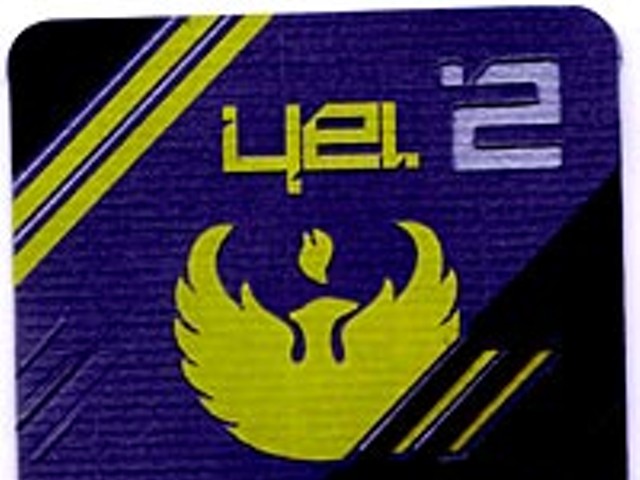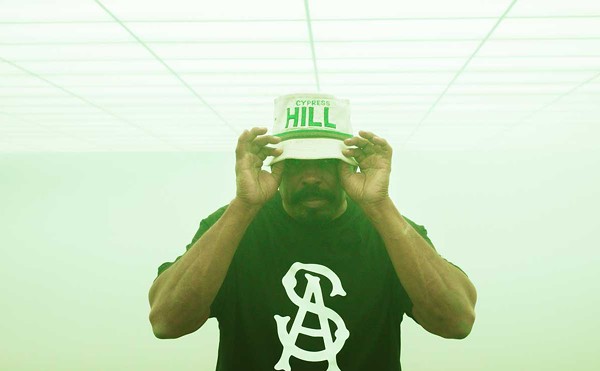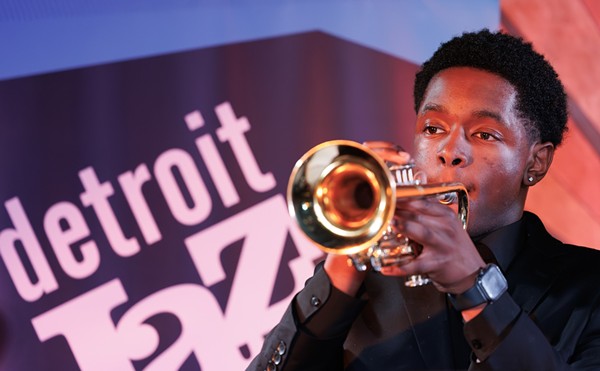It’s been 12 years since Detroit’s most elusive and hugely influential techno squad, Underground Resistance (UR), last surfaced for a live appearance in Detroit. You’d think their upcoming show, Timeline Live, was a comeback attempt or reunion. Or perhaps a promotion for a greatest hits CD. But no news isn’t bad news with this ever-evolving collection of inner-city musicians, producers and DJs, who stay low and, true to their name, definitely stay underground.
Underground Resistance — founded and propelled by Mike Banks (aka Madd Mike, aka 038), who’s instrumental in everything from a church organ pit to the baseball diamond to the music studio — plays only when it wants to.
“The last time UR played live in the city was 1992. Jeff [Mills], Rob [Hood] and I threw the fuck down at a party called Panic in Detroit. That shit was fun,” says Banks over breakfast. “We played for the right guy — my boy Gary Arnett, who used to design art for the camp — and in the right spot. I always liked the State Theatre — it’s not too big.”
Banks believes his music, and the signature sound of Underground Resistance, both a production group and label known for influencing the “Detroit sound,” is so complex that it gets lost in large, open-air, situations.
“That’s why we haven’t played the [Movement] festival,” he says. “Our music needs smaller, darker space. The sound is tighter when enclosed.”
Banks says when he makes music, he closes his eyes and thinks.
“I see a dark room with moving shapes — hot, sweaty and real intense. Not an open-air venue with beautiful people and smiles everywhere.”
All the heavy hitters on Detroit’s techno lineup have played the aforementioned festival by now, regardless of whether it’s been titled DEMF or Movement: Juan, Kevin, both Kennys, Derrick, Richie, Rolando — some have played twice. And those who have passed on playing the festival itself have at least made an appearance on the ever-growing after-party circuit.
You’d think there be one or two parties fitting for the native sound that set Detroit aflame in the early ’90s.
“I wasn’t too down with a lot of the offers we got [to play after-parties]. Most of the promoters were just scramblin’ for tourism dollars. I like supporting the promoters that work year-round, and their smaller events, not the ones during the festival,” Banks says. By way of example he offers up a laundry list of such local players as Beatdown Sounds; Korie; DJ Genesis; Barbara Deyo; Sharif; Paxahau; Mixworks; Keith Butts; Scan 7; Carlos Souffront; and Sam and the Ghostly Crew.
Wizardry
Some of the diversity in Detroit electronic music, and those who enjoy it, is attributable to Jeff Mills, aka The Wizard, who formed UR in 1988 with Banks. His regular radio show on WJLB brought the city to its knees through the ’80s, with combinations of funk, electronic and new-wave music never imagined, mixed quickly and aggressively.
Mills and Banks produced as UR, and for the label by the same name, until 1992, when Mills left to pursue an independent career as a DJ and producer. Known best for cultivating the minimal sounds of techno, Mills formed Axis Records, and has produced more than 50 releases on his label and well-known European staples such as Tresor. Today, Mills continues to push the limits of sound and art through film-scoring projects, arts exhibits and experimental live installations.
“UR is a hard unit to stay with,” says Banks, a guy who rarely gives interviews or allows his picture to be taken. “We don’t make music in search of fame and fortune. We make it when we feel like it. That can be extremely frustrating for artists on the label. Other times an artist’s popularity grows musically and they are forced out by the core members, because that success can endanger the whole.”
That’s what happened with Mills.
“Both Jeff and I realized he had to step into the light,” Banks says. “Jeff, along with Rob Hood, is one of our most talented recruits and was awarded a lifetime member patch from UR. Those guys are always in my heart.”
Banks views UR much like a secret society, or a boot camp. This militant approach isn’t surprising considering the group’s name, and its ongoing mission to awaken the world’s spoon-fed media drones through unfiltered independent messages from the underground. International hits like, “Hi-Tech Jazz,” “Amazon,” “Inspiration,” and Rolando’s “Knights of the Jaguar,” competed with major-label releases overseas and sent their global fan base soaring.
“Once you’re in, you’re always in,” continues Banks. “But if a guy leaves the group, we pull another inner-city musician, like James Stinson (RIP) from Drexciya, up through the ranks.”
UR’s core members consist of contributing artists such as Andre Holland, Gerald Mitchell, Raphael Merriweathers, and Derwin “D-Ha” Hall, who have written, performed or produced the bulk of the UR catalog, which relies completely on live instrumentation, not samples. Other core artists such as Cornelius Harris and Abdul Haqq have represented the camp visually and verbally throughout the years. This core unit doesn’t travel much and doesn’t want to.
“We choose to use the assault DJs to represent the sound,” says Banks. “I see no real reason to send the best producers all over the world when you have real DJs. Not producers-turned-DJs, who are only in it for the cheese. Sometimes that’s frustrating for the producers, and the fans too.”
Sonic warfare
Once a UR DJ achieves a certain amount of recognition, he or she becomes a satellite of Planet UR, according to Banks, and earns a place on The UR Assault Squad. These DJs are known in techno circles worldwide for bringing the sound of the underground to the surface. Not just in hubs like Paris, Tokyo, and Berlin — but also to smaller techno communities in areas less traveled throughout Eastern Europe, South America and the Middle East. The squad acts as UR’s eyes and ears and currently includes James Pennington (aka the Suburban Knight), Buzz Goree (aka Clandestine) and Roland Rocha (Rolando).
“If you’re an assault DJ, we feel you got skills, manners, respect and you’re a good representative of UR’s morals, ethics and sound,” says Banks. “I like to refer to them as recon [reconnaissance] because they go out on missions and come back with what’s happening out there.”
Banks relies on local DJs to monitor the city’s pulse, what’s being produced and played here.
“Locally, our guys broke lots of big records like Aaron Carl’s ‘Down’ on Metroplex. Juan (Atkins) didn’t even know it had broke until he got back to Detroit from traveling, and it was on his label,” Banks says.
With the group’s founders and longtime DJs and producers making such an impact on the formation of techno and how new artists compose and create today, Banks worries about the new generation, and about labels like “legendary” and “old-school” being attached to the UR sound and production style.
“We’ve got a new record out by Chuck Gibson, a younger guy, called Windchimes,” says Banks. “It’s unfair to his music to be labeled as old or classic, especially when it will outsell all kinds of new, overrated tracks made by media babies with promo dollars.”
Banks has good reason to defend the next wave of sonic warriors.
Reinforcements
In 1992, early in the UR miniseries, Banks and partner Christa Robinson founded Submerge Distribution, which distributes Detroit’s premier electronic releases to retail customers and also to individuals via Somewhere In Detroit, an online and appointment-only record store. Submerge exports about 80 percent of the city’s electronic music labels to the world.
“I’m proud that UR had a big part in building Submerge,” says Banks. “But truthfully, that’s all we did. UR only makes music, we don’t run shit.”
When Submerge expanded into a three-story building in New Center, it needed help getting the departments up and running. New talent (Los Angeles implants Santiago and Isela Salazar, and Dan “Dex” Caballero) moved to the Motor City to run mail order and marketing, and native Franki Junjac was brought in for sales. They double as DJs, producers and label owners within the camp.
Submerge got a facelift when Adé Mainor became the director of business operations. It made sense for Mainor to integrate his successful urban electronic label, Electrofunk Records, into the Submerge family. Electrofunk is best known for such urban anthems as “Ass N Titties,” “Sex on the Beach,” “Shake it Baby,” and “Gel and Weave.”
With so much change happening around Banks, it took his original sidekick, Mills, to get him performing again.
“Jeff called me and told me about a project in Japan last October he was working on,” Banks says. “There was a time-sensitive angle, a concept exploring how sound is affected by time.”
Banks agreed to perform live at the installation and produced a show called Timeline that reflected where UR has been and where it’s going. Different musical periods were allowed to affect each other, producing foreign but familiar sounds, warped from their original shape and size.
Percussionist Raphael Merriweathers (aka The Unknown Soldier), best known for his EP Gone But Not Forgotten, joined UR core producer Gerald Mitchell and Banks on keys. Newcomer Dex backed up the group as the Timeline DJ. The trial-run in Tokyo was a success, and only fueled the group’s fire.
It was time to bring the sound back to Detroit.
Artists need access
No one understands the difference between talent and access more than Banks. UR and the Submerge family have cultivated dozens of inner-city musicians and their careers, sending them all over the world to perform and bring new experiences back to the city.
“Sending people out to perform enriches the inner city, where there’s a wealth of talent that often goes undiscovered,” says Banks. “A lot of artists have inspired others through their accomplishments and experiences, and also been able to support themselves and sometimes entire families through music.”
A few of the “techno rebels,” like Kenny Dixon Jr. and the Mahogani Music family, join Banks in giving back to their communities. Many of the techno elite have instead focused on cutting people out of the game, moving out of Detroit or furthering individual initiatives. It’s standard Detroit politics, regardless of genre — some stay, some leave.
This same ethic brought Banks into contact with Detroit Summer, a youth-driven community organization with strong roots in cultural activism. During a panel discussion, he met Detroit Summer’s event coordinator, Ilana “Invincible” Weaver.
Invincible, a local hip-hop artist and community activist, introduced Banks to this 13-year-old group, which originally produced summer programs for Detroit youth. Detroit Summer is now renovating a facility on Cass north of Martin Luther King Boulevard, donated four years ago by the Cass Corridor Neighborhood Development Center. It’s called the Detroit Summer Youth Space, and the group hopes to build a youth-led community media center called the LOUD&Clear Independent Youth Media Center inside the facility.
The space already offers some programs — poetry and photography workshops — but cannot be fully utilized until a new roof is installed and the facility is up to code.
Banks was attracted to the raw elements of the building, and the cause, admitting, “I like a certain degree of unfinished effort. Not a perfect place, but a place where it looks like people are doing their best.”
Banks committed to helping the group when he realized veteran DJ and producer Alvin Hill Jr. (aka Munk) was also involved.
“I could feel Invincible’s passion and motivation for what she wanted to do,” says Banks. “Alvin is a man of exceptional character and his participation lent weight to what Invincible was talking about.”
UR will perform Timeline at the Detroit Summer Youth Space on Memorial Day to “raise the roof” for Detroit Summer’s new effort. Detroit Summer will receive 13 computers from EZ Link, a local group committed to bridging the digital divide, once the roof is installed. The center is set to open in the fall and will provide Internet and computer literacy courses, studios for music and video production, and other programs for young Detroiters.
“The youth in Detroit have so much perspective, but it’s all about access to the mediums that can make their voices and vision heard,” Invincible says. “We know Detroit has so much ingenuity flowing in a place where most people see despair. Now we need the tools to create art and media, bringing these perspectives into the light.”
Banks has seen firsthand what can happen when young talent finds that spotlight, and he hopes the founding fathers of what has become Movement will stay together and see the event through for the same reasons.
“There’s a lot of new, young artists in the city, and they need this,” he says. “They’re depending on the festival organizers, and the city of Detroit, to champion their cause.”
And if the Timeline show is anything like UR’s last live performance in the city 12 years ago, Detroit Summer and its LOUD&Clear Media Center will be able to keep those new artists, and sounds, coming from the Motor City.
UR will perform a rare live set to benefit the Detroit Summer Youth Space and their infrastructure improvements on Monday, May 31, at 3611 Cass Ave. Lineup includes Timeline (live) and the Assault Squad DJs: Rolando, Buzz Goree and James Pennington. For more information about Detroit Summer and the upcoming LOUD&Clear Independent Youth Media Center, call 313-832-2904 or e-mail [email protected]. Summer programs begin June 20.
Keleigh Casper is a freelance writer. Contact her at [email protected]




